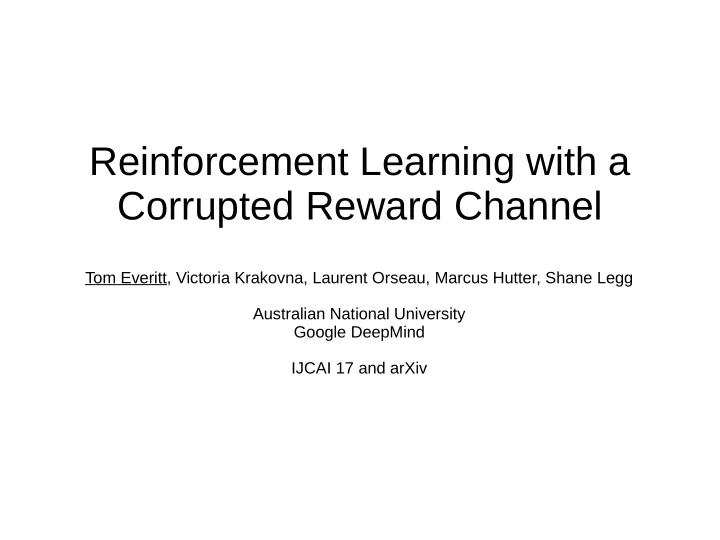

Reinforcement Learning with a Corrupted Reward Channel Tom Everitt, Victoria Krakovna, Laurent Orseau, Marcus Hutter, Shane Legg Australian National University Google DeepMind IJCAI 17 and arXiv
Motivation ● We will need to control Human-Level+ AI ● By identifying problems with various AI-paradigms, we can focus research on – the right paradigms – crucial problems within promising paradigms
The Wireheading Problem ● Future RL agent hijacks reward signal (wireheading) ● CoastRunners agent drives in small circle (misspecified reward function) ● RL agent shortcuts reward sensor (sensory error) ● Cooperative Inverse RL agent misperceives human action (adversarial counterexample)
Formalisation ● Reinforcement Learning is traditionally modeled with Markov Decision Process (MDP): ● This fails to model situations where there is a difference between – True reward – Observed reward ● Can be modeled with Corrupt Reward MDP:
Simplifying assumptions
Good intentions ● Natural optimise true reward using observed reward as evidence ● Theorem: Will still suffer near-maximal regret ● Good intentions is not enough!
Avoiding Over-Optimisation ● Quantilising agent randomly picks a state/policy where reward above threshold ● Theorem: For q corrupt states, exists s.t. has average regret at most ● Avoiding over-optimisation helps!
Richer Information Reward Observation Graphs ● RL: ● Decoupled RL: – States “self-estimate” – Cooperative IRL their reward – Learning values from stories – Learning from Human Preferences
Learning true reward Majority vote Safe state – Cooperative Inverse RL – Learning from Human – Learning values from Preferences stories ● Richer information helps!
Experiments ● AIXIjs: http://aslanides.io/aixijs/demo.html True reward Observed reward
Key Takeaways ● Wireheading: observed reward true reward ● Good intentions is not enough ● Either: – Avoid over-optimisation – Give the agent rich data to learn from (CIRL, stories, human preferences) ● Experiments available online
Recommend
More recommend